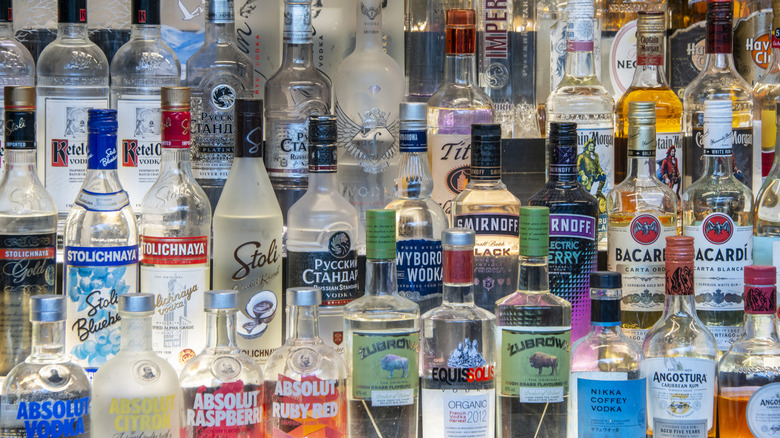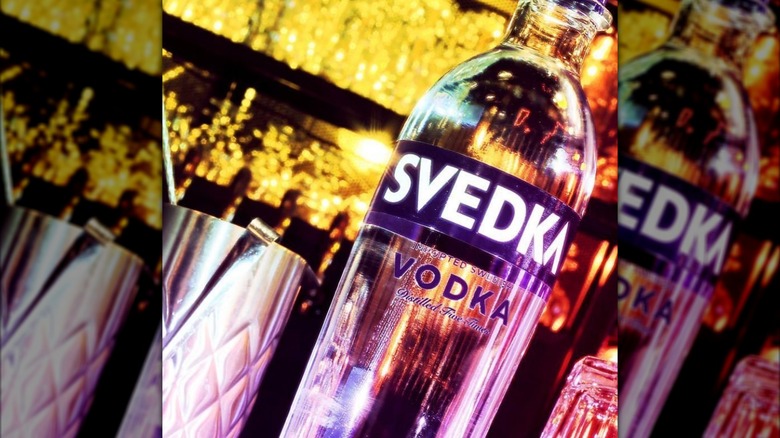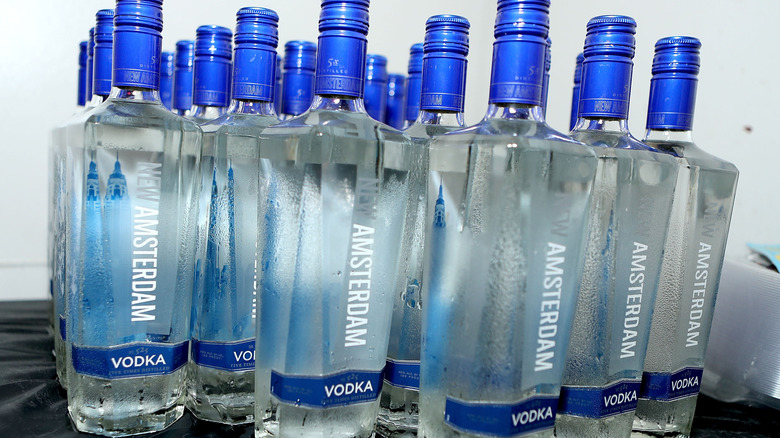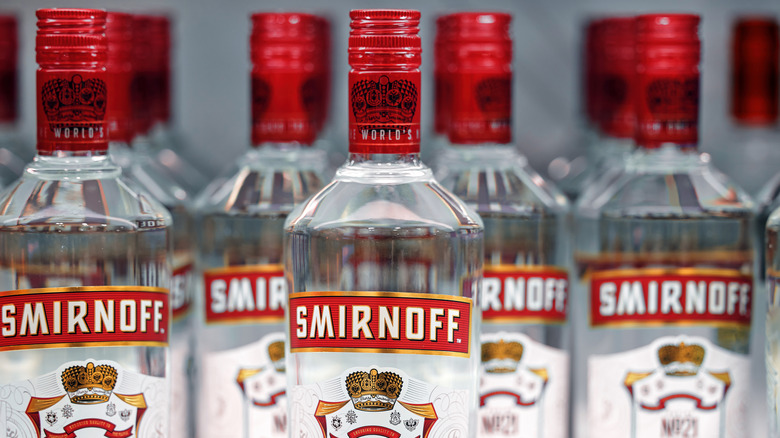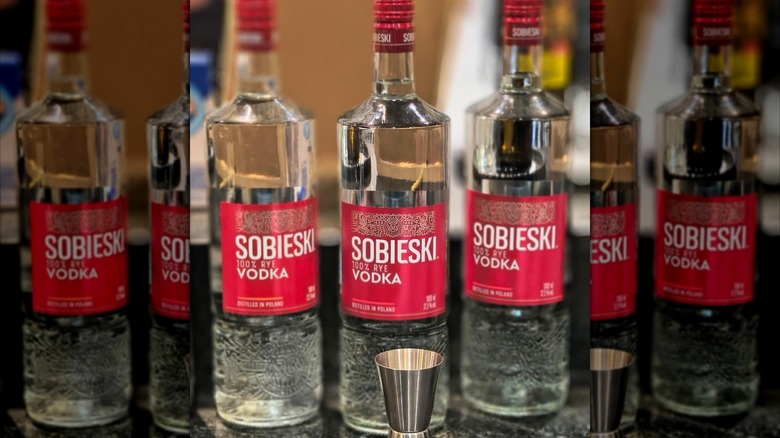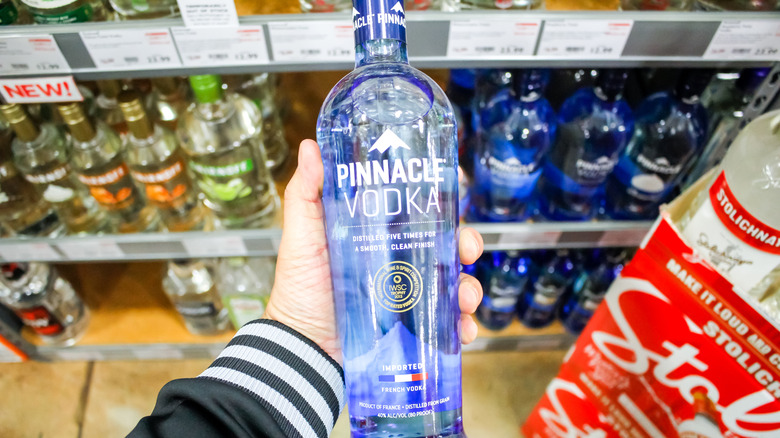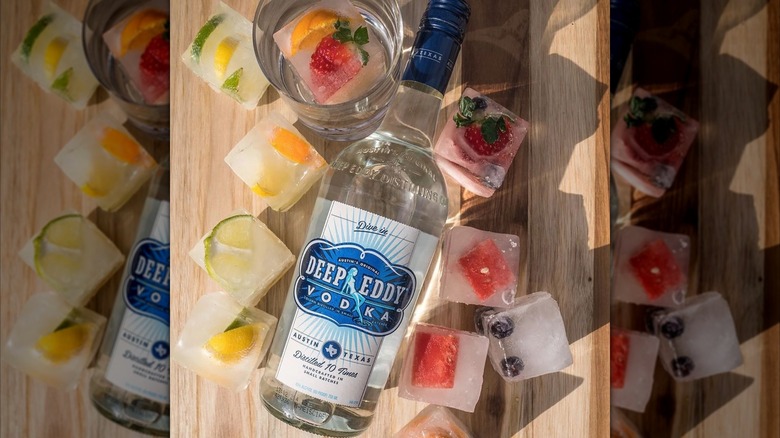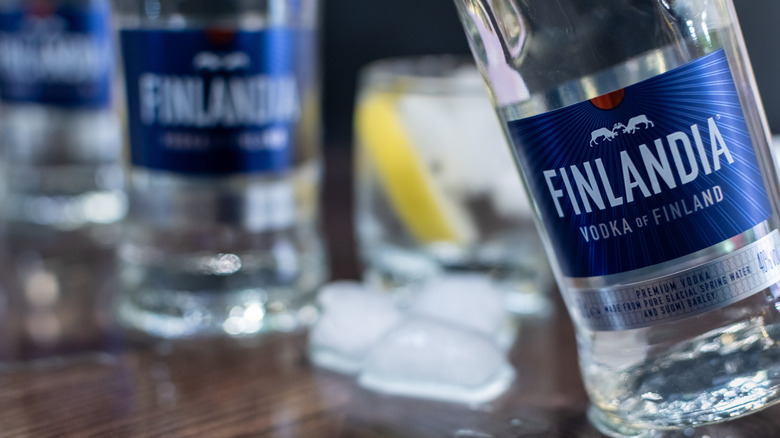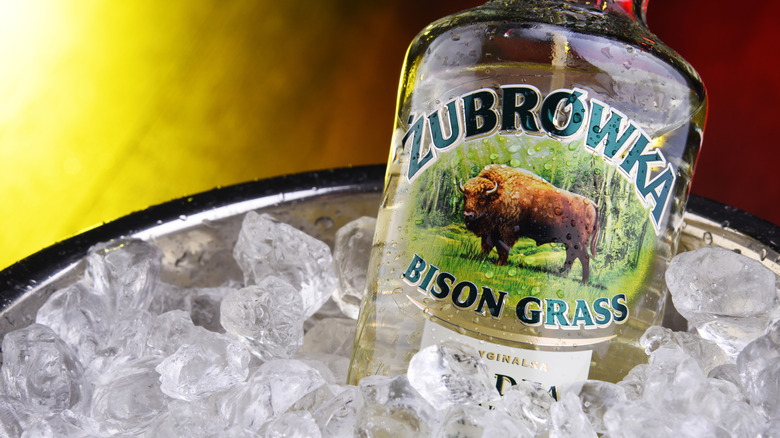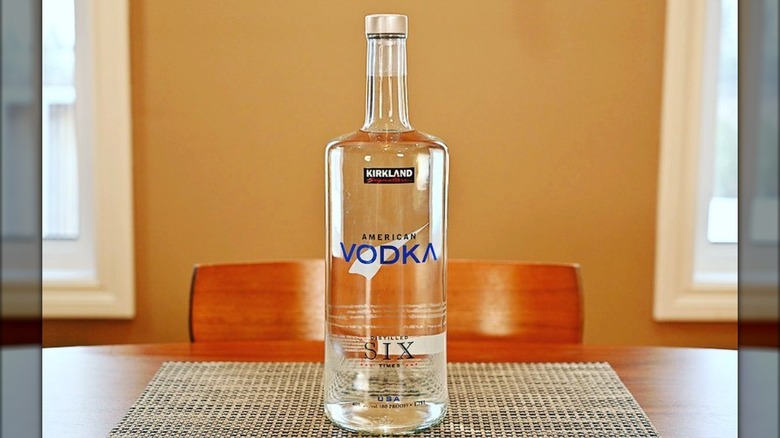Cheap Vodkas That Are Actually Worth Buying
Vodka is one of those spirits that follows us throughout life. We may go through a whiskey phase, but vodka is typically there from the beginning when we start taking shots and mixing drinks. Moreover, it's easy to bring to get-togethers or order with some soda when you're unsure what to drink at the bar. You probably wouldn't want to see the figures, but imagine adding up all the money you've spent on vodka. There must be some cheaper way to fuel our libation indulgences. After all, what's the real difference between cheap and expensive vodka?
You may wonder if all vodka is gluten-free (it generally is, but always read the label, especially if it's a flavored version), but otherwise, not that much changes between brands. The spirit is distilled, and while it can be produced from corn, potatoes, or other grains, the most important consideration is usually that it doesn't taste like bleach. In fact, the whole point of vodka is to be as clean and tasteless as possible. We're looking for something that will go down just as smooth as it will go easy on our wallets — something tasty that won't lead to horrible hangovers, regardless if it's bottom-shelf or well.
Luckily for us, beverage industry veteran and cocktails expert April Wachtel took us through some of the best cheap vodkas that don't sacrifice quality. Founder of Cheeky Cocktails – a line of professional grade, non-alcoholic mixers that simplify labor-intensive cocktails – Wachtel reminded us that "most decent-quality vodkas are very versatile, so it's about finding what works best for you." Take a look at some of the top budget-friendly vodka choices below.
Svedka Vodka
Sometimes, you inevitably end up in one of those situations when a friend gleefully suggests shots. Then you're torn between choosing something easy to take back, but cheap enough to justify the two seconds you'll spend drinking it. "Svedka is a solid, crisp pick," April Wachtel recommended. "For shots, you're looking for options that go down smoothly with minimal burn (unless you're into that sort of thing!)."
Made with U.S. corn and distilled four times, Svedka is the Swedish vodka that many Swedes don't even know exists. Although the bottles were once imported and displayed the country's flag, the company later moved all operations to the U.S., quietly removing all Scandinavian branding. Regardless, it's remained an incredibly inexpensive distilled spirit (hovering around $10 for 750 milliliters) that's so easygoing you won't even need this vodka filter hack to help it go down.
If you're skeptical that such a cheap vodka could make for an enjoyable shot, Wachtel pointed out that price and distillation are not always synonymous with taste. "While 'burn' is partially related to alcohol content, excessive burn is often due to congeners (byproducts of fermentation like methanol and fusel oils)," she explained. "The number of times a spirit is distilled does not technically mean it has fewer congeners (i.e., a smoother sip and a better morning), but the industry uses 'number of times distilled' as a proxy. Unfortunately, this can be misleading, so as always, taste options side by side when possible and trust your palate."
New Amsterdam Vodka
Luckily, if you're roped into a round of vodka shots (willingly or begrudgingly), you've got more than one affordable brand to choose from for a satisfying gulp. "New Amsterdam offers a lightly sweet finish that's easy on the palate," April Wachtel suggested, addressing some of her favorite cheap vodkas for throwing back. You can find New Amsterdam for as low as $10 per 750-milliliter bottle, and the vodka even earned 93 points from The Tasting Panel in 2021. The magazine commended its neutrality and creaminess, noting a spark of white pepper and blue fruit. If straight vodka isn't your thing, it could make for a budget-friendly choice when you order your martini like a pro – or Wachtel also recommends pairing it with cranberry juice.
The brand's website details that it produces its vodka from select grains, distilling it five times and filtering it three times. While you might be tempted to brush these numbers off as marketing jargon, they're really all about the purity of the spirit. Distillation, for example, refers to an early step in the vodka production process, involving boiling the recently fermented liquid. Alcohol has a lower boiling point than water and evaporates first, leaving behind impurities and condensing into a cleaner, more potent liquor. Filtration, then, is one of the final steps before bottling, where the distilled vodka is passed through filters — often activated carbon or charcoal –– to result in a clearer liquid that's less likely to get cloudy with time.
Smirnoff No. 21 Vodka
Maybe your prevailing recollection of vodka is college parties, but you're trying to move past these memories and appreciate the spirit with a more refined palate. Before spending money on top-shelf bottles, you'll probably want to start with something inexpensive to learn what you like. "Smirnoff is a staple, offering subtle almond notes and hints of black pepper, making it a great introduction to vodka," April Wachtel suggested.
Smirnoff has actually been around since 1864, once touted as a favorite of Russian royalty before moving operations overseas and becoming the first U.S. vodka distillery in the 1930s. Given its history, it's no surprise the vodka has remained one of the most recognized budget brands. Wirecutter chose Smirnoff No. 21 classic vodka as one of its top picks, highlighting its "fresher citrus character" and, most importantly, its straightforward versatility. One of Smirnoff's many applications is in the kitchen, for example, in a vodka-infused meat marinade. "I'm personally as discerning when cooking with alcohol as when I'm drinking it, so I'd recommend Smirnoff No. 21," Wachtel said, noting its subtle flavor and affordability. "And you can mix any extra into cocktails."
For boozy party punches, Wachtel proposes Smirnoff Blue Label 100 Proof. "It's a higher-proof version of the classic Smirnoff, offering a clean and neutral profile suitable for any vodka cocktail where you'd like an extra kick," she said. Or if you're feeling a little fancy and just want to sip, Wachtel suggests Smirnoff original with a citrus wedge.
Sobieski Vodka
Another worthy contender that serves as a solid starting point for getting into the world of vodka, Sobieski is a Polish rye-based liquor that's around $12 per 750 milliliters. April Wachtel chose it as one of her top picks for internationally-produced vodkas, describing it as "smooth, budget-friendly, and a bit more characterful than most entry-level options." Plus, you sound more intriguing when you tell your friends you prefer a Polish vodka over the more familiar American brands.
Not only does one of the world's first written accounts of vodka come from Poland, but Sobieski was also named after the 17th-century Polish king and soldier. The brand does not shy away from these bragging rights on its website, revealing some serious pride in its product. To add to its unique edge, the spirit is crafted with Polish spring water and distilled using ancestral methods in the country's tallest 130-foot distillery tower.
A tasting from Spirits Review found the vodka smooth and fragrant, showcasing plenty of sweet and sour notes without any of that stifling rubbing-alcohol profile many cheaper liquors can suffer from. Describing it as leagues above similarly-priced bottles — "an outstanding vodka for the money" — the review recommended Sobieski as an inoffensive and flavorful companion for your martinis. Making martinis is indeed an important step in figuring out which vodkas are for you, according to Wachtel. "Stir (or shake, depending on your preference) it in a martini with dry vermouth and an olive or twist," she advised.
Tito's Handmade Vodka
Founded in 1997, Tito's was the first company in Texas to earn a microdistillery permit since the Prohibition era. In the following decades, the distilled spirit has popped up behind pretty much every bar counter and grocery store shelf, becoming one of our go-to favorites. One Redditor put it plainly: "It's good and smooth. It isn't overly expensive. If I 'accidentally' drink too much, I don't wake up feeling like a 737 is attempting to take off inside my head."
April Wachtel says this familiar brand is also one of the best vodkas for cooking, delivering flavor without overpowering your dish. Try it in your homemade sorbet, vanilla extract, or of course, vodka marinara sauce. Going for just over $15 for 750 milliliters, Tito's is mid-range yet affordable, upholding quality while saving you from using top-shelf in kitchen recipes.
The corn-based vodka is distilled six times, and although it's advertised as "handmade," with such a large operation that's probably no longer the case. But hey, we can overlook the marketing tactic. Take a look on Tito's website and you'll see the liquor is decorated with awards, while drumming up its image as a humble vodka for the everyday folk. Thanks to its smooth, straightforward flavor, Wachtel recommends Tito's for anything from vodka sodas to martinis. "Vodka is neutral by definition, which means that technically, any quality vodka should perform well in cocktails," she explained.
Pinnacle Vodka
Although it sounds contradictory, no flavor is the best flavor for vodka. Many cheap spirits get a lot of flack for their distracting bite, especially when it's reminiscent of nail polish remover. Reviewers may describe a vodka's mouthfeel, notes, or finish, but its overarching flavor should be as clean and unassuming as possible. Going unnoticed lends it greater flexibility, especially for cocktails. "While some people might pick a briny vodka like Pinnacle for a dirty martini, most differences are subtle," said April Wachtel.
Founded in 2002, Pinnacle Vodka operates in the U.S., but imports its wheat-based vodka from France. Distilled five times overseas, the spirit is then sent to Kentucky for flavoring and bottling. Although you can find the distilled spirit in dozens of variations — including habanero, cake, or cucumber — the brand's classic bottle is a straightforward and satisfying budget vodka. Plus, why not make your own cucumber-infused vodka at home?
As well as making a great martini, Pinnacle's original vodka can work well in must-try vintage cocktails like a Vesper or Gibson. Before you start getting fancy with cocktails, though, the same rules apply to Pinnacle as any other affordable vodka brand: "First, sip it neat," Wachtel advised. "You should always taste before you mix so you know what you're working with." If you need a chaser, Wachtel recommends following Pinnacle with pickle brine for "a vodka version of a pickleback."
Deep Eddy Vodka
Named after a local swimming hole where all the cool kids hang out, Deep Eddy brands itself as the vodka for effortlessly fun vibes. The company got its start in 2010 in Austin, Texas, but has already become the easily-recognizable vodka we'll grab before heading off to the lake. For one, the 750-milliliter bottle costs under $15, but most importantly, it tastes good. April Wachtel named Deep Eddy one of her favorite U.S. brands, describing it as "smooth, affordable, and mixable."
Speaking of mixing, sweet and summery cocktails seem to be Deep Eddy's forte. The company offers fruity flavors like lemon, sweet tea, and cranberry, setting itself apart from other flavored spirits by using real fruit juice. Bartenders on Reddit raved just how well these varieties hit the spot: "Personal favorite was to use both of [Deep Eddy's] lemon and ice tea flavors to make John Daly shots," one user wrote. "VERY dangerous because of how smooth it goes down."
Distilled ten times then filtered four times through charcoal, even Deep Eddy's original vodka is a solid product for the price. Tastings highly recommended the classic with 88 points, noting its pleasant warmth and hints of marzipan. It mixes especially well with ginger beer for a Moscow Mule, which Wachtel suggests as another essential cocktail to try when figuring out which vodkas are for you.
Finlandia Vodka
The first Scandinavian vodka to be imported into the U.S. in the '70s, Finlandia is also known as the first "designer vodka," thanks to its partnerships with famous Finnish designers and sculptors who design the brand's bottles. Currently, the bottles resemble melting ice, crafted by designer Harri Koskinen. Melting ice also happens to be central to the brand's identity, since the final step in the production process involves blending the distilled spirit with glacial water from springs.
April Wachtel described Finlandia as one of the "dependable imports that won't break the bank." While the company properly started up in 1970, the microdistillery had been operating since 1888, implementing a unique distillation process in which the barley-based liquor is continuously distilled for over 50 hours. For around $18 per 750 milliliters, the brand's unique edge is alone worth the price.
Redditors on a vodka thread shared their love for its subtle flavors and easy-going mouthfeel. "Finlandia is an excellent bottle for its price point. Very smooth," one user wrote. "The standard vodka has a polite vodka flavor that isn't as heavy as Russian vodka." A review from Difford's Guide even described Finlandia as the epitome of vodka, highlighting just how "extraordinarily clean" it tasted, and noting a hint of black pepper and bitterness on the finish. "See how it pairs with soda and lime," Wachtel suggested, once you've tried it neat.
Żubrówka Bison Grass Vodka
When we asked April Wachtel which cheap vodkas she thought deserved more attention, she admitted, "I've always had a soft spot for Żubrówka Bison Grass vodka from Poland." Pronounced "zoo-broof-ka," this rye-based vodka is flavored with bison grass. Collected from the sprawling Bialowieza forest, these grasses aren't exactly bison food, rather the soft and medicinal grasses the buffalo roam through. Distilled six times and filtered through charcoal, the vodka is then filtered through bushels of grass to achieve its characteristic meadowy flavor. Each bottle comes with your very own blade of bison grass inside.
Although commercial production began in 1928, the brand famously follows a medieval recipe dating back hundreds of years. The liquor grew as a cult classic throughout the 20th century, becoming one of the world's top-selling vodkas by 2019. If you've never heard of it, that could be because it's only been available in the U.S. since around 2010. The FDA considers coumarin — a naturally-occurring chemical in the buffalo grass — toxic, hence the spirit's forbidden-fruit status. The brand spent decades working on a coumarin-free version, which you can now find for about $25 per 750 milliliters, making it an intriguing mid-range pick.
Described as herbal, creamy, and sweet, the spirit is traditionally mixed with apple juice. "Try it with apple juice and a pinch of cinnamon," Wachtel suggested. It would also mix well with ginger ale — or if you've really got a sweet tooth, over some vanilla ice cream.
Kirkland Signature Vodka
Kirkland Signature has amassed a gravitational field of vodka-enthusiasts (and not just because you can buy a huge 1.75-liter bottle for as little as $13). "Kirkland Signature is Costco's house brand that performs surprisingly well in blind tastings alongside more expensive options," April Wachtel said, acknowledging it could possibly pass for a vodka twice its price. In some taste tests, drinkers have even preferred Costco's distilled spirit over top-shelf brands.
Kirkland Signature offers both French and American styles of vodka. The French variety tastes so good that fans long believed it was actually Grey Goose in disguise, although Grey Goose later dispelled these rumors. The lore may be a lot to live up to, but the American variety is similarly outstanding, taking home Wirecutter's best vodka pick in 2024. Describing it as citrusy, smooth, and devoid of harshness, the review raves that it works well for just about everything. If you're looking for a premium flavor, the French bottle probably delivers a more complex and refined vodka, but it is a bit more expensive. For budget and quality, the American variety is your best bet.
Clean, corn-based, and distilled six times, this spirit would be great to test in an espresso martini, which Wachtel points out is another important cocktail in your vodka-tasting journey. "At the end of the day, it's about your taste and your aesthetic preference," she advised. "Try a few and see what you like best!"
